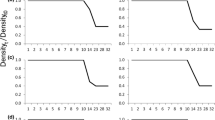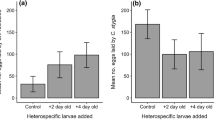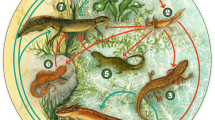Abstract
The size structure of a larval population facilitates interaction asymmetries that, in turn, influence the dynamics of size-structure. In species that exhibit conspicuous aggressive interactions, the competitive effects of the smaller individuals may be overlooked. We manipulated initial size differences between two larval cohorts and young-cohort density of Salamandra infraimmaculata in mesocosms to determine: (1) whether young individuals function primarily as prey or as competitors of older and larger individuals; (2) the resulting dynamics of size variation; and (3) recruitment to the postmetamorph population. Intercohort size differences generally remained constant over time at low young-cohort densities, but reduced over time at high densities due to retardation of the old-cohort growth rate. This suggests a competitive advantage to the young cohort that outweighs the interference advantage of older cohorts previously documented in this species. The increase in mortality from desiccation due to high young-cohort density was an order of magnitude greater in the old cohort than in the young-cohort, further indicating size-dependent vulnerability to competition. However, the conditions least favorable to most of the old-cohort larvae (large size difference and high young-cohort density) promoted cannibalism. Among cannibals, mortality and time to metamorphosis decreased and sizes at metamorphosis increased substantially. Thus, a balance between the competitive advantage to young cohorts, and the interference and cannibalism advantage to old cohorts shapes larval size-structure dynamics. Larval densities and individual expression of cannibalism can shift this balance in opposite directions and alter relative recruitment rates from different cohorts.



Similar content being viewed by others
References
Anholt BR (1994) Cannibalism and early instar survival in a larval damselfly. Oecologia 99:60–65
Bar-David S et al (2007) Long-distance movements by fire salamanders: integration of capture-recapture and genetic data and implications for conservation. Ecological Society of America Annual Meeting Abstracts
Blank L et al (2013) Genetic population structure of the endangered fire salamander (Salamandra infraimmaculata) at the southernmost extreme of its distribution. Anim Conserv 16:412–421
Blaustein L, Friedman J, Fahima T (1996) Larval Salamandra drive temporary pool community dynamics: evidence from an artificial pool experiment. Oikos 76:392–402
Claessen D, de Roos AM, Persson L (2000) Dwarfs and giants: cannibalism and competition in size-structured populations. Am Nat 155:219–237
Claessen D, de Roos AM, Persson L (2004) Population dynamic theory of size-dependent cannibalism. Proc R Soc Lond B 271:333–340
De Block M, Stoks R (2004) Cannibalism-mediated life history plasticity to combined time and food stress. Oikos 106:587–597
Degani G (1993) Cannibalism among Salamandra salamandra (L) larvae. Isr J Zool 39:125–129
Degani G, Goldenberg S, Warburg MR (1980) Cannibalistic phenomena in Salamandra salamandra larvae in certain water bodies and under experimental conditions. Hydrobiologia 75:123–128
Eitam A, Blaustein L (2002) Noninvasive individual identification of larval Salamandra using tailfin spot patterns. Amphib Reptil 23:215–219
Eitam A, Blaustein L, Mangel M (2005) Density and intercohort priority effects on larval Salamandra salamandra in temporary pools. Oecologia 146:36–42
Grant JWA, Girard IL, Breau C, Weir LK (2002) Influence of food abundance on competitive aggression in juvenile convict cichlids. Anim Behav 63:323–330
Hastings A, Costantino RF (1991) Oscillations in population numbers: age-dependent cannibalism. J Anim Ecol 60:471–482
Hjelm J, Persson L (2001) Size-dependent attack rate and handling capacity: inter-cohort competition in a zooplanktivorous fish. Oikos 95:520–532
Hopper KR, Crowley PH, Kielman D (1996) Density dependence, hatching synchrony, and within-cohort cannibalism in young dragonfly larvae. Ecology 77:191–200
Huss M, Bystrom P, Persson L (2008a) Resource heterogeneity, diet shifts and intra-cohort competition: effects on size divergence in YOY fish. Oecologia 158:249–257
Huss M, Bystrom P, Strand A, Eriksson LO, Persson L (2008b) Influence of growth history on the accumulation of energy reserves and winter mortality in young fish. Can J Fish Aquat Sci 65:2149–2156
Huss M, van Kooten T, Persson L (2010) Intra-cohort cannibalism and size bimodality: a balance between hatching synchrony and resource feedbacks. Oikos 119:2000–2011
Kaspersson R, Höjesjö J, Pedersen S (2010) Effects of density on foraging success and aggression in age-structured groups of brown trout. Anim Behav 79:709–715
Loman J (2002) When crowded tadpoles (Rana arvalis and R. temporaria) fail to metamorphose and thus fail to escape drying ponds. Herpetol J 12:21–28
Persson L (1985) Asymmetrical competition: are larger animal competitively superior? Am Nat 126:261–266
Polis GA (1981) The evolution and dynamics of intraspecific predation. Annu Rev Ecol Syst 12:225–251
Polis GA (1988) Exploitation competition and the evolution of interference, cannibalism and intraguild predation in age/size-structured populations. In: Ebenman B, Persson L (eds) Size-structured populations: ecology and evolution. Springer, Berlin
Preisser EL, Bolnick DI, Benard MF (2005) Scared to death? The effects of intimidation and consumption in predator–prey interactions. Ecology 86:501–509
Reques R, Tejedo M (1996) Intraspecific aggressive behaviour in fire salamander larvae (Salamandra salamandra): the effects of density and body size. Herpetol J 6:15–19
Sadeh A (2012) Kin-selective cannibalism and compensatory performance in larval salamander cohorts inhabiting temporary pools. Evol Ecol Res 14:113–123
Sadeh A, Mangel M, Blaustein L (2009) Context-dependent reproductive habitat selection: the interactive roles of structural complexity and cannibalistic conspecifics. Ecol Lett 12:1158–1164
Sadeh A, Truskanov N, Mangel M, Blaustein L (2011) Compensatory development and costs of plasticity: larval responses to desiccated conspecifics. PLoS ONE 6:e15602
Segev O, Blaustein L (2014) Influence of water velocity and predation risk on fire salamander (Salamandra infraimmaculata) larval drift among temporary pools in ephemeral streams. Freshw Sci 33:950–957
Segev O, Mangel M, Wolf N, Sadeh A, Kershenbaum A, Blaustein L (2011) Spatiotemporal reproductive strategies in the fire salamander: a model and empirical test. Behav Ecol 22:670–678
Smith CK (1990) Effects of variation in body size on intraspecific competition among larval salamanders. Ecology 71:1777–1788
Spencer M, Schwartz SS, Blaustein L (2002) Are there fine-scale spatial patterns in community similarity among temporary freshwater pools? Glob Ecol Biogeogr 11:71–78
Steinfartz S, Veith M, Tautz D (2000) Mitochondrial sequence analysis of Salamandra taxa suggests old splits of major lineages and postglacial recolonizations of Central Europe from distinct source populations of Salamandra salamandra. Mol Ecol 9:397–410
van den Bosch F, de Roos AM, Gabriel W (1988) Cannibalism as a life boat mechanism. J Math Biol 26:619–633
Walls SC, Jaeger RG (1987) Aggression and exploitation as mechanisms of competition in larval salamanders. Can J Zool 65:2938–2944
Warburg MR (1992) Breeding patterns in a fringe population of fire salamanders, Salamandra salamandra. Herpetol J 2:54–58
Warburg MR, Degani G, Warburg I (1979) Growth and population structure of Salamandra salamandra (L) larvae in different limnological conditions. Hydrobiologia 64:147–155
Werner EE (1994) Ontogenetic scaling of competitive relations: size-dependent effects and responses in two anuran larvae. Ecology 75:197–213
Wissinger SA, Whiteman HH, Denoel M, Mumford ML, Aubee CB (2010) Consumptive and nonconsumptive effects of cannibalism in fluctuating age-structured populations. Ecology 91:549–559
Ziemba RE, Collins JP (1999) Development of size structure in tiger salamanders: the role of intraspecific interference. Oecologia 120:524–529
Ziemba RE, Myers MT, Collins JP (2000) Foraging under the risk of cannibalism leads to divergence in body size among tiger salamander larvae. Oecologia 124:225–231
Acknowledgments
Many thanks to Arik Kershenbaum, Lior Blank, Michal Segoli, Orr Spiegel, and Tobin Northfield for their feedback on the manuscript. This study was funded by Israel Science Foundation grant (961-2008) awarded to LB, and by Postdoctoral Award No. FI-457-2011 from BARD, The United States-Israel Binational Agricultural Research and Development Fund, awarded to AS. The study was carried out in accordance with the Israeli Nature and Parks Authority permit 2010/37885, and with the University of Haifa Animal Experimentation Ethics Committee permit 212/11.
Conflict of interest
The authors have no conflict of interest.
Author information
Authors and Affiliations
Corresponding author
Additional information
Communicated by Ross Andrew Alford.
Rights and permissions
About this article
Cite this article
Sadeh, A., Polevikov, A., Mangel, M. et al. Intercohort size structure dynamics of fire salamander larvae in ephemeral habitats: a mesocosm experiment. Oecologia 179, 425–433 (2015). https://doi.org/10.1007/s00442-015-3366-7
Received:
Accepted:
Published:
Issue Date:
DOI: https://doi.org/10.1007/s00442-015-3366-7




